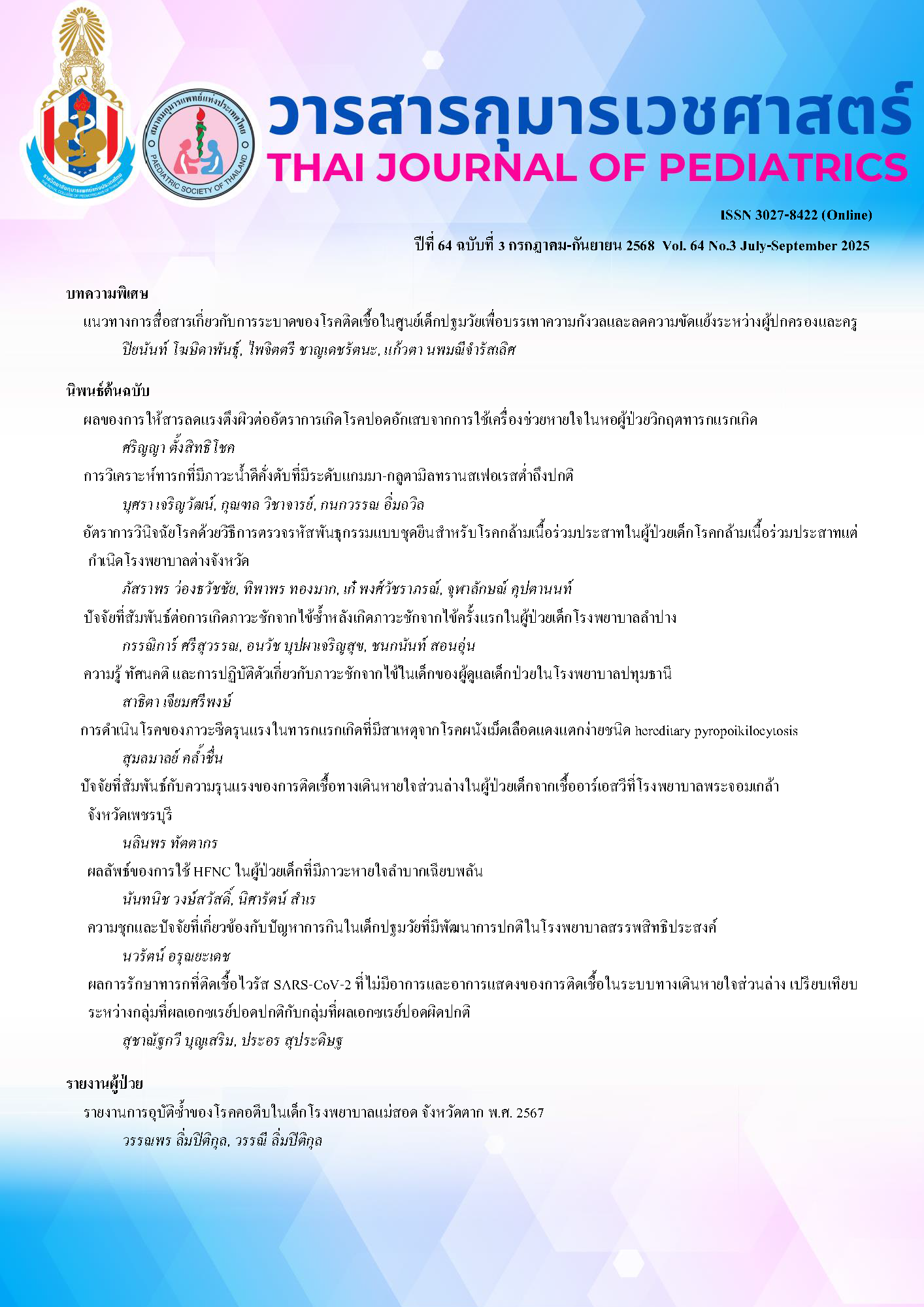Communication strategies on infectious disease outbreaks in early childhood centers to alleviate parental concerns and reduce conflicts with teachers
Keywords:
Conflict reduction in communication, infectious diseases, communication techniques, epidemic controlAbstract
Advancements in medical technology have significantly improved the accuracy of pathogen identification, leading to increased public awareness of infectious diseases, particularly following the COVID-19 pandemic. Merely recognizing an infection as viral is no longer sufficient; the public now demands precise information regarding the specific pathogen, disease severity, and appropriate preventive measures. This article presents communication strategies and techniques that pediatricians can utilize to educate and guide teachers in effectively engaging with parents. These strategies aim to alleviate anxiety, reduce panic, and prevent conflicts. Key components include building trust, fostering two-way communication, engaging in meaningful conversations, mastering the art of active listening, utilizing techniques to facilitate communication, and employing nonverbal communication. Implementing these approaches can enhance mutual understanding between teachers and parents, ensuring smoother interactions and minimizing potential conflicts. Beyond communication techniques, teachers should possess a fundamental understanding of infectious diseases, outbreaks, and preventive strategies to accurately and confidently convey relevant information to parents. Strengthening their knowledge in these areas ensures that information is communicated with clarity and reliability, ultimately fostering a more informed and cooperative school environment.
Downloads
References
กรมควบคุมโรค, กองโรคติดต่อ. สถานการณ์โรคติดต่อในเด็กปี 2566: 5 โรคที่สำคัญ. นนทบุรี: กรมควบคุมโรค; 2566.
Lertsuphotvanit S, Kloimklinsuk A, Sanaprom J, Tongfak O, Ponsanong N. Guidelines for control and prevention of disease and health hazard for childcare teacher. Nonthaburi: Department of disease control (TH); 2023.
หลักการจัดการโรคติดเชื้อในโรงเรียนและศูนย์เด็กเล็ก. CIM Journal [Internet]. Available from: https://cimjournal.com/confer-update/chain-of-infection/ [cited 24 Feb 2025]
European centre for disease prevention and control. Guidelines for non-pharmaceutical interventions to reduce the impact of COVID-19 in the EU/EEA and the UK [Internet]. Stockholm: ECDC; 2020 [cited 2024 Nov 11]. Available from:https://www.ecdc.europa.eu/sites/default/files/documents/novel-coronavirus-guidelines-non-pharmaceutical-measures_0.pdf.
ราชวิทยาลัยกุมารแพทย์แห่งประเทศไทย. คำแนะนำโรคไอกรนสำหรับบุคลากรทางการแพทย์. 14 พฤศจิกายน 2567. Available from: https://pidst.or.th/A1472.html [cited 24 Feb 2025]
ราชวิทยาลัยกุมารแพทย์แห่งประเทศไทย. คำแนะนำโรคไอกรนสำหรับประชาชน. 14 พฤศจิกายน 2567. Available from: https://www.pidst.or.th/A1473.html [cited 24 Feb 2025]
Cauchemez S, Ferguson NM, Wachtel C, Tegnell A, Saour G, Duncan B, et al. Closure of schools during an influenza pandemic. Lancet Infect Dis. 2009;9:473-81.
Schneiders ML, Naemiratch B, Cheah PK, Cuman G, Poomchaichote T, Ruangkajorn S, et al. The impact of COVID-19 non-pharmaceutical interventions on the lived experiences of people living in Thailand, Malaysia, Italy and the United Kingdom: A cross-country qualitative study. PLoS One. 2022 ;17:e0262421.
Chase R, Valorose J. Exploring and developing communication strategies with parents [Internet]. Wilder Research; 2019 [cited 2024 Nov 11]. Available from: https://files.eric.ed.gov/fulltext/ED612478.pdf.
Marvel MK, Epstein RM, Flowers K, Beckman HB. Soliciting the patient's agenda: Have we improved? JAMA. 1999;281:283-7.
Texas children's hospital. Communicating with pediatric patients and their families: The texas children’s hospital guide for physicians, nurses, and other healthcare professionals. Houston (TX): Texas children's hospital. 2015 p. 17-21.
Heritage J, Robinson JD, Elliott MN, Beckett M, Wilkes M. Reducing patients' unmet concerns in primary care: the difference one word can make. J Gen Intern Med. 2007;22:1429-33.
Platt FW, Gordon GH. Field guide to the difficult patient interview. 2nd ed. Philadelphia: Lippincott Williams & Wilkins; 2004. Chapter 2, Listening p. 14-17.
Myerscough PR, Ford M. Talking with patients: keys to good communication. Oxford (UK): Oxford University Press; 1996 p. 16.
Downloads
Published
How to Cite
Issue
Section
License
Copyright (c) 2025 The Royal College of Pediatricians Of Thailand

This work is licensed under a Creative Commons Attribution-NonCommercial-NoDerivatives 4.0 International License.



